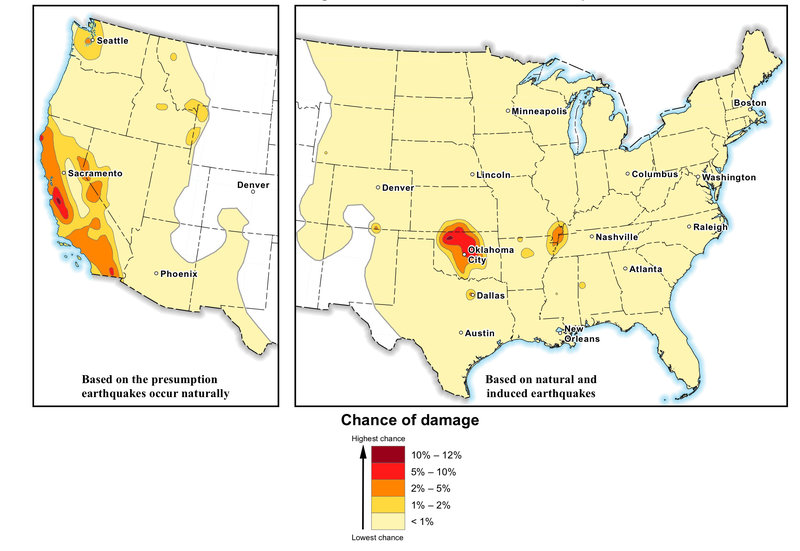
It’s no secret that California is prone to earthquakes. In 2008, researchers predicted the Golden State has a 99 percent chance of having a magnitude 6.7 or larger quake before the year 2040, and a 46 percent chance of having a magnitude 7.5 or greater quake.
To put that into perspective, the infamous earthquake that struck San Francisco in April 1906 was a magnitude 7.8. It caused massive destruction and killed an upwards of 2,000 people.
While earthquakes aren’t quite as severe in Texas and Oklahoma (the largest were around 5.5 magnitudes), their frequency has skyrocketed to the point where these states are now as likely as California to experience quakes.
This phenomenon isn’t natural, either. The soaring prevalence of earthquakes in Texas and Oklahoma is a man-made problem, created by the oil and gas industry via hydraulic fracking, a process involving the high-pressure injection of millions of gallons of water mixed with chemical additives into rock formations deep underground.
Man-made quakes
As a result, an estimated 7 million have abruptly been positioned in earthquake zones.
“There are 21 hot spots where the quakes are concentrated; they’re in places where, historically, noticeable earthquakes were rare: Texas, Colorado, Arkansas, Kansas, New Mexico, and Oklahoma. Ohio and Alabama have also experienced some induced quakes,” reports National Public Radio.
A map released by the U.S. Geological Survey illustrates areas within the U.S. that could “experience damage from natural or human-induced earthquakes in 2016.” The greatest threat lies along the Oklahoma/Kansas border and the San Francisco Bay area.
 The map below highlights 21 areas where scientists have documented “rapid changes in seismicity that have been associated with wastewater injection. The map also shows earthquakes — both natural and induced — recorded from 1980 to 2015 in the central and eastern U.S. with a magnitude greater than or equal to 2.5.”
The map below highlights 21 areas where scientists have documented “rapid changes in seismicity that have been associated with wastewater injection. The map also shows earthquakes — both natural and induced — recorded from 1980 to 2015 in the central and eastern U.S. with a magnitude greater than or equal to 2.5.”
As illustrated, the risk of natural quakes hasn’t changed much, but the same cannot be said for manmade quakes, which USGS says have increased tenfold.
Less than 10 years ago, Oklahoma had only one or two magnitude 4.0 earthquakes per decade, according to Live Science. But over the past year, the state has had an upwards of 900 noticeable quakes, said Mark Petersen, USGS seismic hazard expert.
“Seventy percent of the earthquakes in the central U.S. happened in Oklahoma, and that’s a huge change to the background rate,” said F. Rall Walsh III, a doctoral student in geophysics at the Stanford School of Earth, Energy and Environmental Sciences. “We expect California to have a lot of earthquakes, but not Oklahoma — but now, Oklahoma is having more earthquakes than California.”
Wastewater injection wells
“Petersen says induced quakes have become more frequent because there’s more wastewater from oil and gas operations around the country that has to be disposed of. Companies pump it down into underground wells, and sometimes that water raises pressure on underground faults that then slip and cause small quakes,” writes NPR.
Though the majority of quakes occurring in Texas and Oklahoma reach a magnitude of around 3 or 4, some are magnitudes of 5 or higher, which is large enough to cause damage to homes, infrastructure, and roadways.
“I think that we need help people understand that they do face a risk in these areas of induced earthquake activity,” Petersen told NPR, adding that “they need to take precautions just like people in California do.”
The oil and gas industry continues to deny the impact fracking has on the environment, arguing the increase in earthquakes is a result of natural causes. The industry largely minimizes the environmental impacts of waste wells, saying the risk level is low.
But earthquakes are not the only concern regarding wastewater injection wells, as they have also been linked to water contamination, toxic leaks, and the destruction of ecosystems.
Sources:


